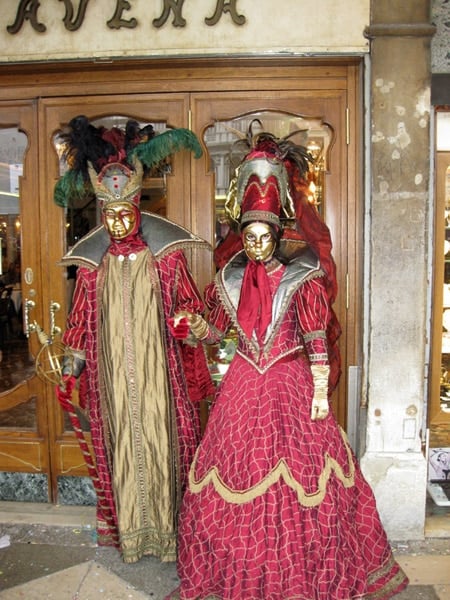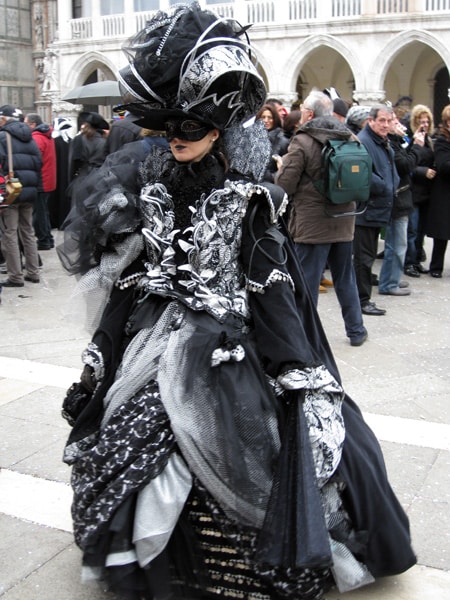
A white wig of curls and a plume of feathers piled high on my head and donning a Burgandy Victorian dress, my husband and I hopped the train headed to Venice for its most famous 10-day street party: Carnevale.
I felt like a movie star must feel every day as people at our local train station pointed and shouted “Masqueraders!” at us. My husband, Tim, turned to me and said “People are staring.” Why yes they were. It’s not every day Marie Antoinette and the Plague Doctor are riding the train with you.
Having attended the previous year with only a mask, I decided it would be much more fun to celebrate the 2011 Carnevale in true Venetian style. We donned our masks and posed with countless tourists for picture after picture as we made our way from the train station to St. Mark’s Square, where the parade of costumes culminates in all its colorful glory.
“This must be what it’s like to be famous,” I thought as the flash bulbs popped and people lined up to have their photograph taken with me. Donning the costume made me truly appreciate the mystery that you could be anyone behind that mask.
History of Venice Carnival
Carnival started in the 15th century as a time for celebration and expression throughout the classes. Wearing masks hid any form of identity between social classes; the fishmonger could attend the ball and dance with the baroness.
During the Carnival period Venice offered numerous possibilities for spending money, attracting princes from all over Europe anxious to spend their fortunes. The choices were various, with activities such as gambling dens, brothels, theaters, cafés, wine shops (both licensed and illicit) and restaurants, as well as booths where one could see exotic animals, ropewalkers and jugglers.

The Doges condemned it and the Popes denounced it, but nothing could dampen the Venetian Carnevale spirit until Napoleon arrived in 1797 and put an end to the festivities.
Resuscitated during the 1970s by the Italian government, who decided to bring back the history and culture of Venice, they used Carnevale to lure the tourists during the empty winter months when tourism came to a screeching halt.
Today around 30,000 tourists flock to Venice per day during the two-week Carnevale period.
Venetian Masks
Masks have always been a central feature of the Venice Carnival and made it unique. If you could not identify the wearer of the mask, you could not know his social status. In this way, Venice temporarily overturned her social order. Some of the masks depicted Commedia dell’Arte characters; others were more sinister.
The white-beaked mask so famous from photographs is that of the Medico Della Peste or plague-doctor; the beak echoes a doctor’s long breathing apparatus that held a sponge doused in vinegar, thought to hold the plague at bay. The Doges were frequently exercised by the dangers masks allowed and passed laws limiting their use to within the Carnival period; if you wore a mask at any other time of year, penalties were severe.
Venetian masks are readily available all over Venice. Inexpensive masks can be found for less than €10 at vendors’ booths outside of the train station and in many of the stalls along the Rialto. More expensive hand-made masks can be found in little shops tucked away in the calles (streets) of Venice and in the shops around St. Mark’s Square and range anywhere from €30 to several hundred depending on how elaborate they are.
Carnival Events

Venice becomes a stage for Carnival from February 11th through 21st this year. You can enjoy the mystery of Carnival and join the general celebration for free. Masks and costumes are everywhere; groups travel in coordinated getups that range from the Tragicomica clowns to the court of the Sun King in all its wigged-out, over-the-top, drag-queen glory. St. Mark’s Square is the place to see and been seen. Rent your own costume and join the fun!
If you are going to splurge to attend ones of Venice’s elite masked balls, Il Ballo del Doge or Doge’s Ball is the most famous and will take place on February 18th. Tickets start at €650 per person and can be reserved online.
Less extravagantly priced events include the Secrets of Venice Carnival Walking Tour, in which you follow in the steps of Giacomo Casanova while a masked guide tells stories of the history of Carnival (€30 per person) or the Carnival Pub Crawl on which you will visit four local bars to sample local wine and the Venetian Sprizt (€35 per person).
For a bit of romance try the Dolce Carnival! tour. Dressed in your Carnevale finest, you can ride in a gondola down the Grand Canal and visit privately owned palaces at which a sommelier will chose Venetian wines and desserts for you to enjoy (€135 per person).

Tim and I will be masquerading once again this year and celebrating the beginning of the Carnival of Venice as an acrobat leaps off the Campanile and swings across St. Mark’s Square with a triumph of confetti and colored air balloons.
About The Author
Jennifer Dombrowski is a training specialist and social media strategist in the field of higher education. Based in Italy with her husband, Tim, they have a passion for travel and love discovering the world. Follow her on twitter @jdomb.













Another great article, Jennifer! Love the pictures too!!
Thanks, Ruth! I’ve got to give the credit on the photos to my husband, Tim. He’s the photographer on our trips and does a wonderful job!
These pics are great! Good work Jennifer. I would love to go there with my wife.
Ahh Venice- I am so envious. Did you go to the Ponte delle Tette?
(Bonus points to anyone who knows what that means without looking it up.)
Nice article – Thank you! I’m going to Venice for Carnivale next February, and I was just wondering – do you need to take dance classes before attending the balls?
Thank you!